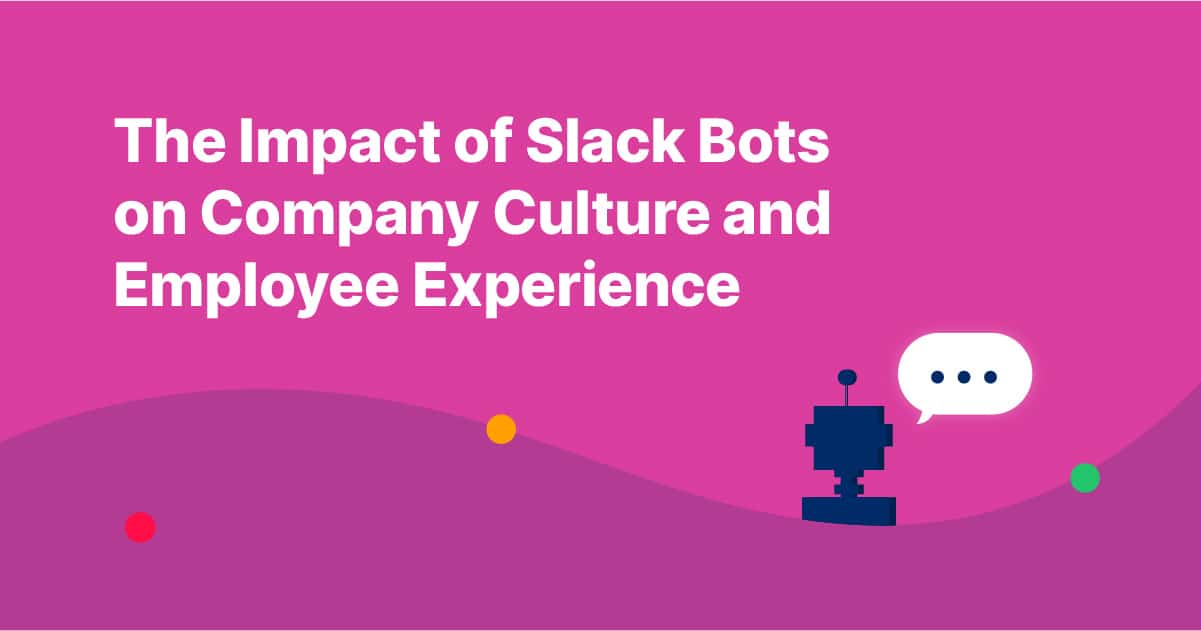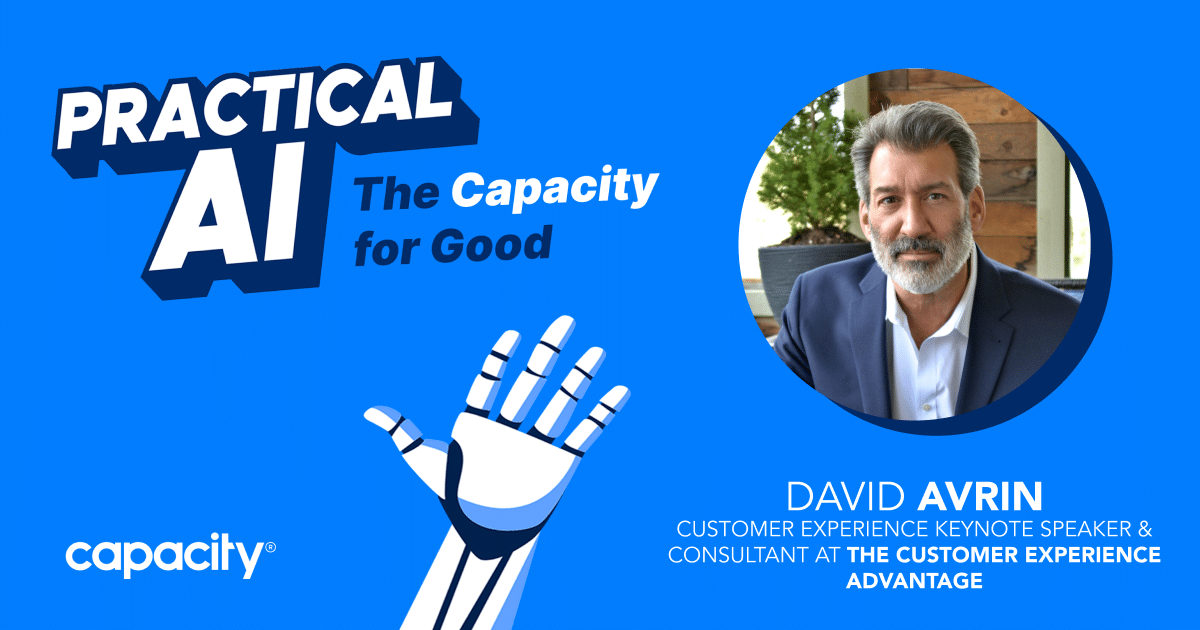Slack is one of the most popular communication tools used by businesses today. It is a collaboration hub that allows team members to communicate and share information in real-time. One of the unique features of Slack is the ability to add intelligent bots, which can automate various tasks and assist employees. In this article, we will explore the impact of Slack bots on company culture and employee experience and discuss how they can benefit organizations.
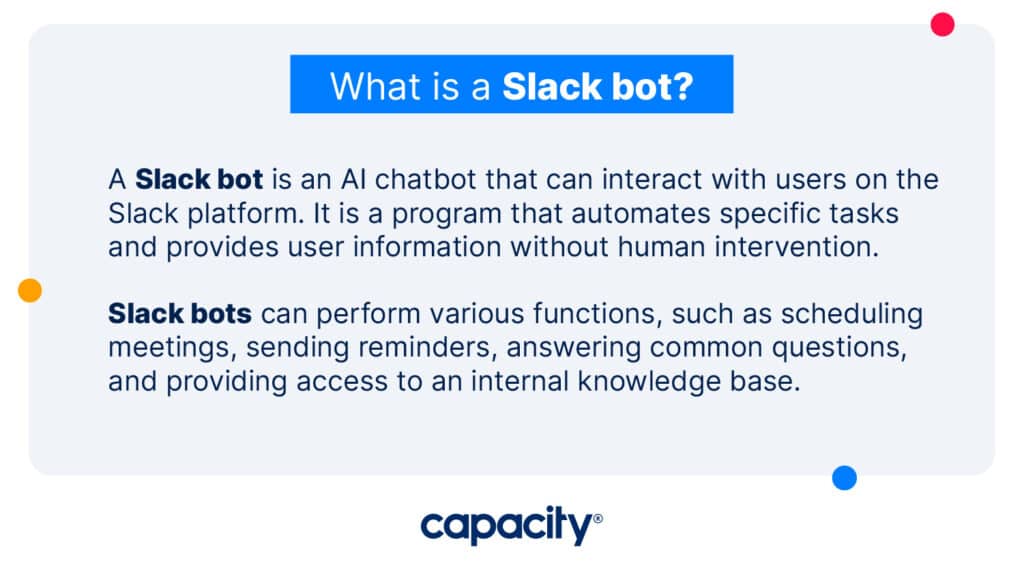
What is a Slack bot?
A Slack bot is an AI chatbot that can interact with users on the Slack platform. It is a program that automates specific tasks and provides user information without human intervention.
Slack bots can perform various functions, such as scheduling meetings, sending reminders, answering common questions, and providing access to an internal knowledge base.
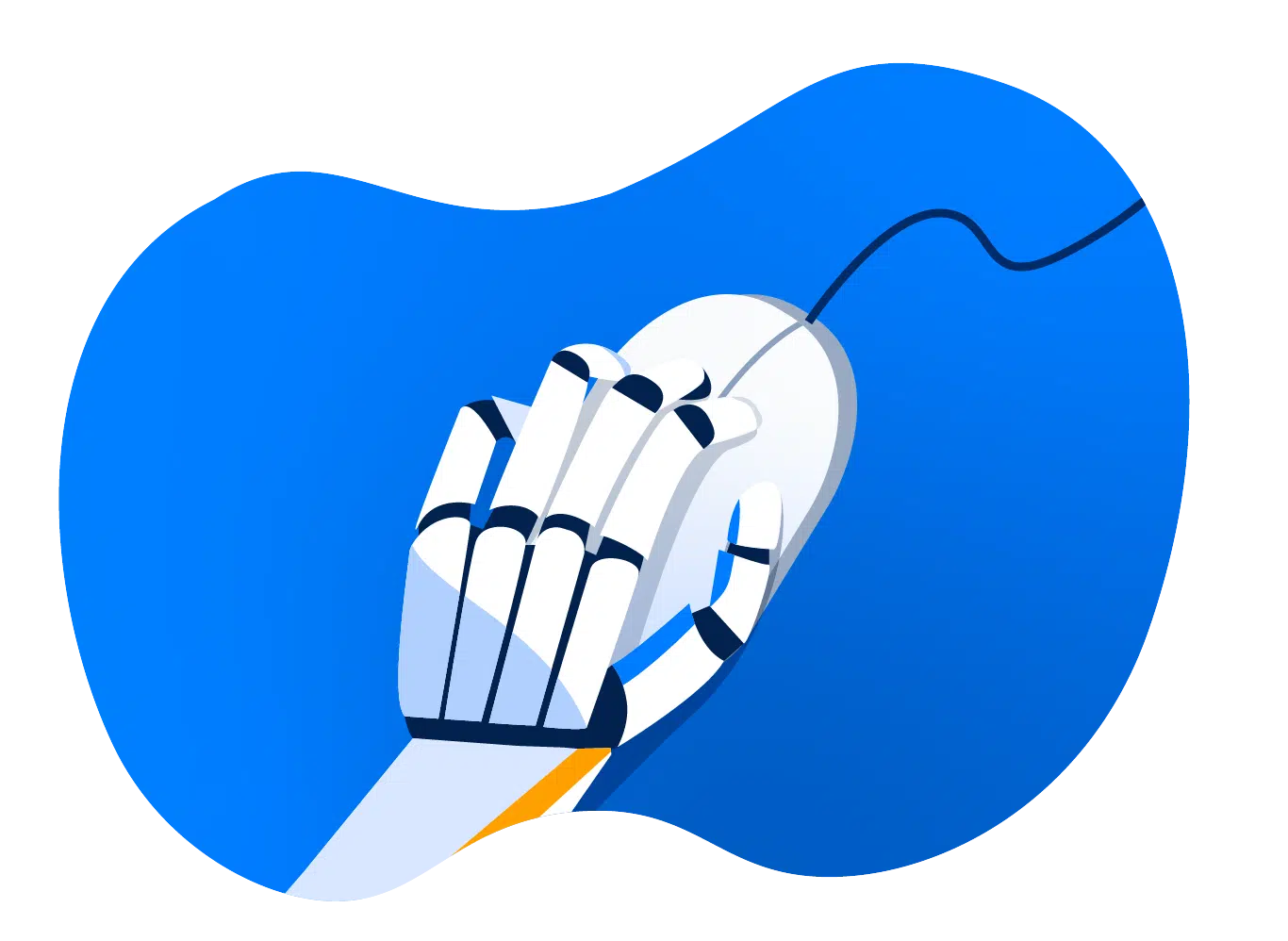
Automate Your Work
Capacity’s enterprise AI chatbot can help:
- Answer FAQs anytime, anywhere
- Find relevant documents within seconds
- Give surveys and collect feedback
What tasks can a Slack Bot perform for you?
Slack bots can perform a wide variety of tasks to help streamline communication and automate workflows in the workplace. Here are some examples of tasks that a Slack bot can perform:
- Respond to frequently asked questions: A Slack bot can provide automated responses to common questions that employees may have, such as HR policies or IT support issues.
- Schedule meetings: A Slack bot can be integrated with a calendar app to allow users to schedule and send invitations directly from Slack.
- Manage to-do lists: A Slack bot can manage and update task lists, allowing users to add and complete tasks directly from Slack.
- Provide reminders and notifications: A Slack bot can be programmed to send reminders and notifications to users about upcoming deadlines or important events.
- Monitor social media: A Slack bot can monitor social media channels for mentions of the company or brand, allowing teams to respond promptly to customer inquiries or comments.
- Automate internal processes: A Slack bot can automate internal processes like employee onboarding or approval workflows.
- Track metrics: A Slack bot can track team performance or customer engagement metrics, providing real-time updates and insights.
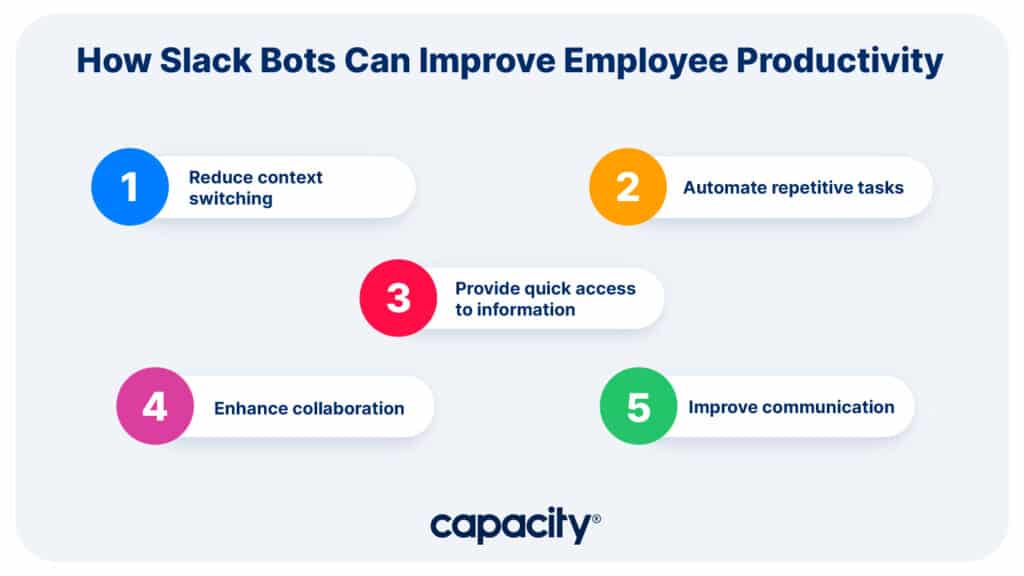
How Slack Bots Can Improve Employee Productivity
Slack bots are becoming increasingly popular in the workplace, and for a good reason. By automating repetitive tasks and streamlining communication, Slack bots can help improve employee productivity in several ways.
Here are some specific ways in which Slack bots can boost productivity:
Reduce context switching
Context switching, or moving between different tools and applications to perform tasks, can be a significant productivity drain. Slack bots can help reduce context switching by allowing employees to perform tasks without leaving the Slack platform.
Automate repetitive tasks
Repetitive tasks, such as responding to emails or updating spreadsheets, can take up a lot of time and energy. Slack bots can automate these tasks, allowing employees to focus on more meaningful work.
Support automation platforms like Capacity can seamlessly integrate with Slack to help answer tedious FAQs automatically, ultimately reducing shoulder taps for employees. It’s a win-win!
Provide quick access to information
Slack bots can be programmed to provide quick access to information, such as company policies or project status updates. This can save employees time and reduce the need for back-and-forth communication.
Enhance collaboration
Slack bots can facilitate collaboration by providing a centralized platform for communication and collaboration. This can help employees work more efficiently and effectively as a team.
Improve communication
Slack bots can help improve communication by automating notifications, providing quick access to information, and streamlining workflows. This can reduce misunderstandings and ensure that everyone is on the same page.
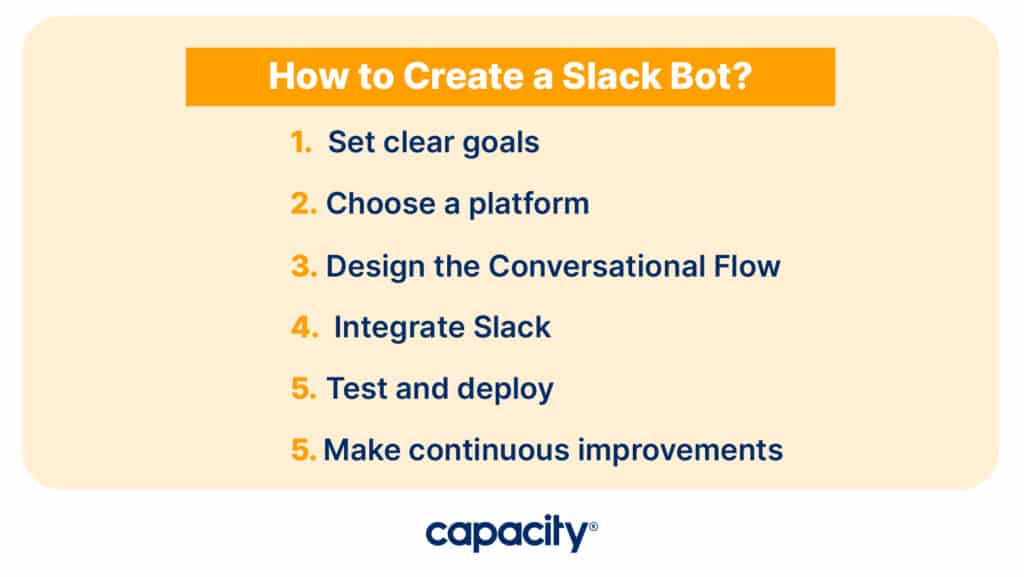
How to create a Slack Bot?
Implementing a Slack chatbot can be a powerful tool for streamlining communication and productivity within a team. Follow these steps to create your Slack bot for your org:
1. Set clear goals
First and foremost, it’s crucial to identify the purpose of the chatbot and the tasks it will be responsible for. This includes determining its functionality and the type of content it will deliver. Determine the intention of your chatbot and what tasks you want it to perform. This will help you design your bot more effectively and ensure that it meets the needs of your team.
2. Choose a platform
Choosing the right platform for your chatbot can make all the difference in providing excellent customer experiences. A good AI chatbot platform can reduce waiting times, handle more queries, and improve the user experience. Whether you’re in customer support, sales, or marketing, selecting the right AI chatbot platform is crucial in providing your customers with the best possible experience. Don’t underestimate the significance of making the right choice- it could mean the difference between happy and frustrated customers!
3. Design the conversational flow
Designing your chatbot’s conversational flow is one of the most critical steps in creating a successful bot. A good bot should be able to understand and respond to user input accurately to provide a compelling customer experience. You can use natural language processing (NLP) to create meaningful conversational flows for your chatbot.
4. Integrate Slack
The next step is to connect your chatbot to the Slack platform. This will allow your chatbot to interact with other users on the platform and enable you to benefit from Slack’s features.
5. Test and deploy
Once you have created your chatbot, testing it before deploying it in production is essential. Test the bot’s conversational flows to ensure they are accurate and no errors occur. Test your chatbot in development and then launch it on the Slack platform.
6. Make continuous improvements
After testing, refine the chatbot and make any necessary improvements to ensure it is optimized for production. Track metrics such as user engagement, response times, and task success rates to ensure your bot performs optimally.
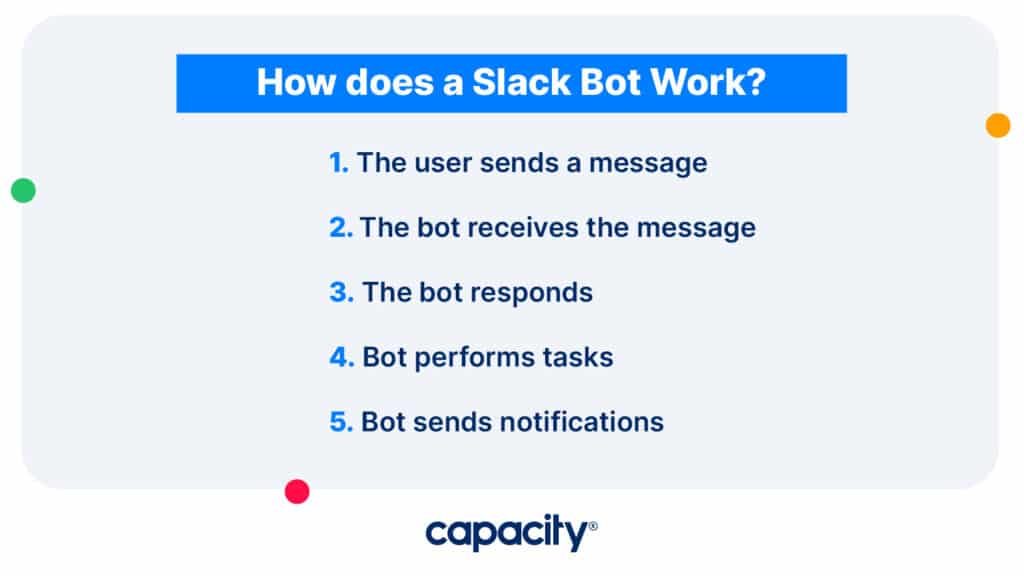
How does a Slack bot work?
Here’s how a breakdown of how a Slack bot works:
- The user sends a message: A user sends a message to a Slack channel or direct message to the bot.
- The bot receives the message: The Slack bot receives it and uses an API (application programming interface) to read the message and interpret its meaning.
- The bot responds: Based on the message content, the bot responds with a message in the same channel or via a direct message.
- Bot performs tasks: In some cases, the bot may be programmed to perform a task based on the user’s message, such as creating a calendar event or updating a task list.
- Bot sends notifications: The bot can notify users of specific events, such as when a task is completed, or a new message is received in a channel.
Behind the scenes, a Slack bot is essentially a web application hosted on a server and communicates with Slack through the API.
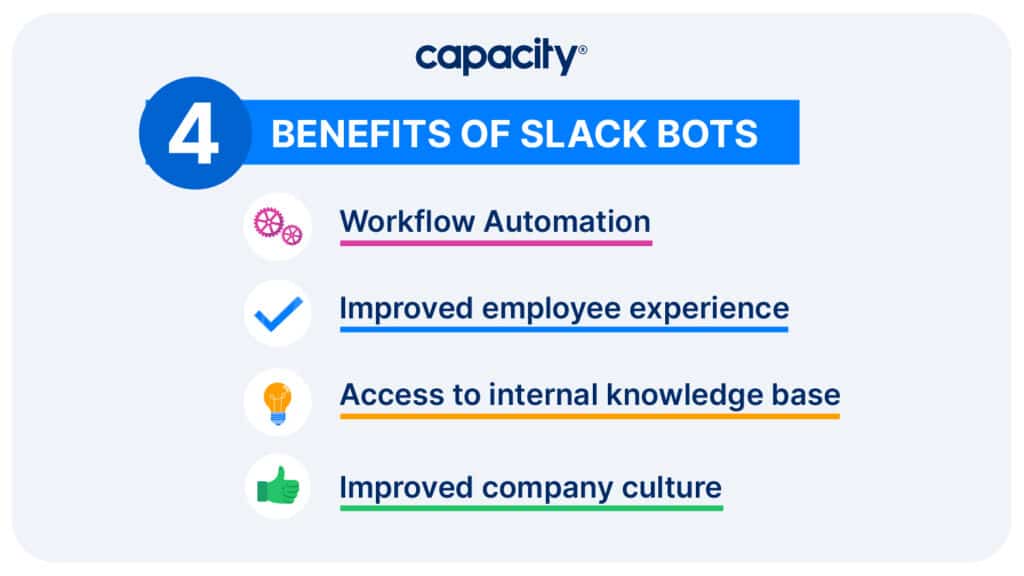
Benefits of Slack Bots
Slack bots can provide several benefits to organizations, including:
Workflow automation
Slack bots can automate many tasks that would otherwise require human intervention. For example, a bot can be set up to schedule meetings, send reminders, or notify team members of important events. This automation can save time and improve efficiency, allowing employees to focus on more critical tasks.
Improved employee experience
Slack bots can also provide a better employee experience by providing quick and easy access to information. For example, a bot can be set up to answer common questions, reducing the need for employees to search for information manually. This can save time and improve productivity, making it easier for employees to finish their work.
Access to an internal knowledge base
Slack bots can help provide access to an internal knowledge base. This can be a valuable resource for employees, providing them with the information they need to do their jobs effectively. By making this information readily accessible through a bot, employees can save time and avoid the frustration of searching for data manually.
Improved company culture
Slack bots can also contribute to positive company culture by fostering collaboration and communication. For example, a bot can be set up to facilitate team-building activities or provide daily updates on company news and events. This can help employees feel more connected to the company and each other, improving morale and job satisfaction.
See how the Capacity team uses the platform internally to save valuable time.
How can Capacity Help You Create a Slack Bot?
Capacity is a platform that can help you easily create a Slack bot, even if you don’t have programming experience. With Capacity, you can create a custom AI chatbot that integrates with Slack and other messaging platforms. Here are some ways Capacity can help you create a chatbot:

Automate Your Work
Capacity’s enterprise AI chatbot can help:
- Answer FAQs anytime, anywhere
- Find relevant documents within seconds
- Give surveys and collect feedback
No coding required
Capacity’s drag-and-drop interface allows you to build a bot without writing a single line of code. You can create a chatbot in minutes and integrate it with Slack with just a few clicks.
Natural language processing
Capacity’s AI chatbot uses natural language processing (NLP) to understand and respond to user messages. This means your bot can interpret and respond to user questions and requests conversationally, just like a human.
Pre-built integrations
Capacity comes with pre-built integrations for popular messaging platforms, including Slack. You can connect your bot to Slack and start communicating with employees immediately.
Workflow automation
Capacity can automate workflows by integrating with other business applications, such as Salesforce, HubSpot, and Zendesk. Your bot can automatically update customer records, create support tickets, and more.
Internal knowledge base
Capacity can create an internal knowledge base for your employees, providing instant access to company information and resources. Your bot can answer common questions, provide training materials, and even provide onboarding support for new hires.








































